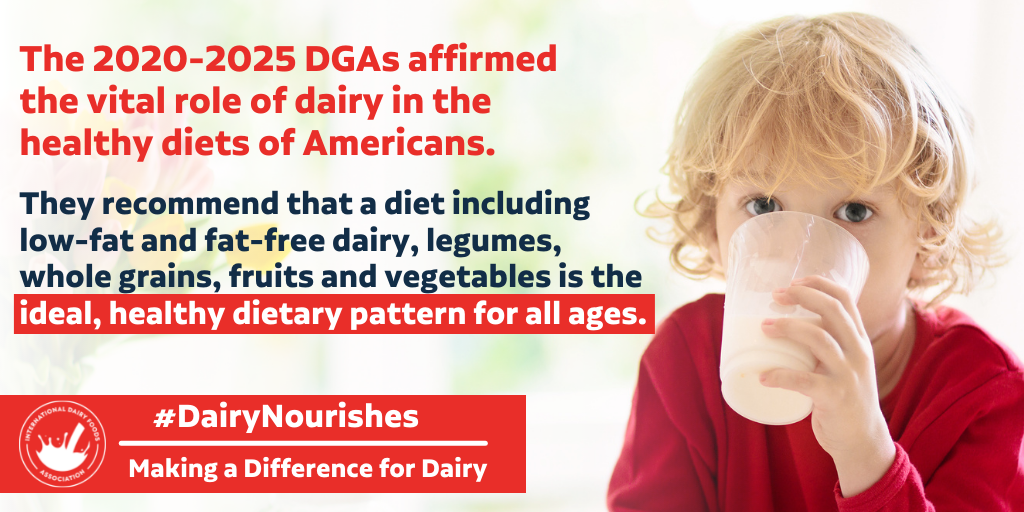IDFA’s Dairy Nourishes campaign provides expert insights from diet and health professionals as well as the latest research and news about dairy’s positive impact on child and adult health and wellness. Browse IDFA's Dairy Nourishes resource center below to learn more about this impact, explore dairy's central role in federal nutrition policy like the the Dietary Guidelines for Americans and the White House Conference on Hunger, Nutrition, and Health, and spread the word on social media about how #DairyNourishes.

Good nutrition is the foundation of health and wellness for adults and children alike, and dairy is a crucial part of a healthy diet beginning at a very young age. In fact, no other type of food or beverage provides the unique combination of nutrients that dairy contributes to the American diet, including high quality protein, calcium, vitamin D, and potassium, and health benefits including better bone health and lower risk for type 2 diabetes and cardiovascular disease.
Cow’s milk alone has been found to hydrate the body better than water and delivers 13 essential nutrients that everyone needs to stay healthy. Recently, a panel of experts from the Academy of Nutrition and Dietetics, the American Academy of Pediatric Dentistry, the American Academy of Pediatrics, and the American Heart Association, concluded that cow’s milk—whole, low fat and skim milks—offers a host of essential nutrients that young kids need to be healthy, while recommending parents strictly limit or eliminate all other beverages from their child's diet except for water.
Dairy products play a critical role in the diet of children, where milk is the top source of calcium, potassium, phosphorus, and vitamin D in kids ages 2-18. According to the U.S. Departments of Agriculture and Health and Human Services, American children and adolescents over four years old are not consuming enough dairy to meet the Dietary Guidelines for Americans (DGAs) recommendations. Case in point: 73 percent of the calcium available in the food supply is provided by milk and milk products; and milk is the number one source of protein in the diets of children ages 2 to 11.
Moreover, a growing body of data and research underscores the role that dairy—at all fat levels—should play in a healthy diet. In fact, a growing body of evidence indicates that consumption of full-fat dairy foods (milk, cheese and yogurt) is not associated with higher risk of negative health outcomes, including obesity, diabetes and heart disease.
Milk provides a unique combination of nutrients to American diets. Milk contains thirteen essential nutrients, including three of the four nutrients identified as dietary components of public health concern in the 2020-2025 Dietary Guidelines for Americans (DGA)—calcium, vitamin D and potassium. Milk provides 22% of the calcium, 40% of the vitamin D and 10% of the potassium in the American diet. In addition to these nutrients, milk is also a good source of protein, vitamin A and B vitamins, combining into a nutrient package not found in other foods or beverages. Read more about the nutritional benefits of milk here, and share information about milk's 13 essential nutrients using the graphics below.
Cheese is a flexible way to get a serving of nutrient-dense dairy: it can be a snack on its own or as part of an entrée or meal. Cheese is an important source of high-quality protein, especially for meat-free meals or snacks. In fact, cheese even included as a meat alternate in the school meal programs! And when cheese is visibly served with other nutrient-dense foods, like fruits, vegetables and whole grains, the consumption of those other heathy options is also increased. Read more about the nutritional benefits of cheese here.
Yogurt is a nutrient-dense food that is a good source of protein, calcium, riboflavin, vitamin B12, and phosphorous. Some yogurts have vitamin D added. Read more about the nutritional benefits of yogurt here.

Millions of Americans struggle with hunger. Millions more struggle with diet-related diseases—like heart disease and diabetes—which are some of the leading causes of death and disability in the U.S. In 2022, the White House will host a conference on hunger, nutrition and health to examine these issues.
Importantly, dairy products and the dairy industry can and should play a central role in alleviating hunger and nutrition issues in the U.S. IDFA in recent weeks has offered the White House our support and provided policy recommendations to ensure Americans--particularly low-income Americans--have access to affordable, nutritious dairy products:
Every five years, USDA and HHS update the Dietary Guidelines for Americans, which sets the standards for federal feeding programs like the national school breakfast and lunch programs, and nutrition education messages. In December 2020, the agencies once again released guidelines that affirm the unparalleled health and nutrition benefits that dairy products provide to people of all ages:
The Dietary Guidelines rely on the best science to advise Americans on building a wholesome, nutritious diet containing a range of foods and beverages. They are developed after years of review of the latest science on health and nutrition by the Dietary Guidelines Advisory Committee (DGAC), a panel of twenty leading dieticians physicians and public health experts, and officials at USDA and HHS.
Here how IDFA made a difference for dairy through advocacy on the Dietary Guidelines: